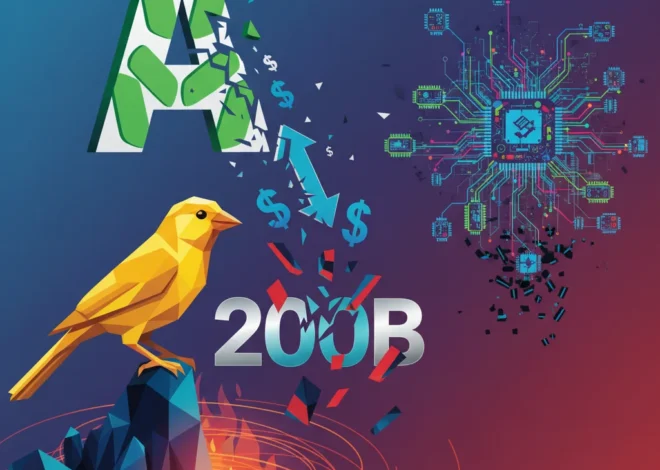
The Great AI Power Play: Is Big Tech Forcing the EU to Back Down on Its Landmark AI Act?
For years, the tech world has watched the European Union with a mix of apprehension and admiration. The bloc has consistently positioned itself as the world’s digital referee, crafting ambitious regulations like GDPR to tame the Wild West of the internet. Its next great project, the EU AI Act, was poised to be the most comprehensive and influential piece of artificial intelligence legislation on the planet—a global gold standard for safe and ethical AI.
But in the high-stakes game of technology and power, nothing is ever that simple. A seismic shift is underway in Brussels. According to a recent bombshell report from the Financial Times, the European Commission is now proposing to “pause” key provisions of the very rule book it championed. The reason? Intense pressure from some of the biggest names in technology.
This isn’t just a minor legislative tweak. It’s a potential U-turn that could redefine the future of AI development, regulation, and innovation for years to come. So, what exactly is happening, why is Big Tech so invested, and what does this mean for developers, startups, and the future of the software you use every day?
The Original Blueprint: A Risk-Based Revolution for AI
Before we dive into the controversy, it’s crucial to understand what made the EU AI Act so groundbreaking. Unlike a one-size-fits-all ban, the Act was designed around a sophisticated, risk-based pyramid. The idea was to regulate the application of AI, not the technology itself, with rules proportional to the potential for harm.
- Unacceptable Risk: This category included AI systems considered a clear threat to people’s safety and rights. Think government-run social scoring systems or real-time biometric surveillance in public spaces (with some exceptions). These would be flat-out banned.
- High Risk: This was the core of the regulation. It covered AI used in critical infrastructure, medical devices, hiring software, and law enforcement. These systems would face strict requirements for transparency, human oversight, and data quality before they could enter the market.
- Limited Risk: AI systems like chatbots would have to be transparent, ensuring users know they are interacting with a machine.
- Minimal Risk: The vast majority of AI applications, like spam filters or video game AI, would be left largely unregulated.
This tiered approach was hailed as a smart, balanced way to foster innovation while protecting citizens. The EU’s goal was to create the “Brussels Effect”—where EU laws become the de facto global standard because companies prefer to adopt a single, strict set of rules for their products worldwide.
The Foundation Model Wrench in the Works
The original draft of the AI Act was conceived before the explosive arrival of generative AI and “foundation models” like OpenAI’s GPT-4 and Google’s PaLM 2. These massive, general-purpose machine learning models are the engines behind tools like ChatGPT and Bard. They aren’t designed for one specific “high-risk” task; they can be adapted for almost anything, from writing poetry to generating programming code.
This created a huge regulatory headache. How do you classify a technology that could be used to write a high-school essay (minimal risk) one minute and a malicious phishing email (a major cybersecurity threat) the next? Regulators decided the answer was to regulate these powerful models at the source. The original plan was to designate them as “high-risk” by default, forcing their creators to meet stringent transparency, safety, and documentation requirements.
And that’s when the alarm bells started ringing in Silicon Valley and beyond.
Big Tech’s Billion-Dollar Pushback
The world’s largest tech companies, including Microsoft, Google, and OpenAI, along with some of Europe’s own AI champions, launched a massive lobbying effort. Their argument, as detailed in the Financial Times report, is that shackling foundation models with “high-risk” regulations would be a death blow to European innovation.
They contended that such rules would:
- Stifle Innovation: The immense cost and complexity of compliance would slow down research and development, putting EU-based companies at a permanent disadvantage against competitors in the US and China.
- Create Unfair Burdens: It’s impractical, they argue, for a model’s creator to foresee and mitigate every possible downstream use of their technology. The responsibility, in their view, should lie with the companies that build specific applications on top of the foundation model.
- Harm Open-Source Development: Many powerful AI models are released as open-source software. Forcing small teams or non-profits to undergo a high-risk compliance process would be impossible, effectively killing the open-source AI movement in Europe. This view was strongly supported by a Franco-German push to ease the rules on foundation models, as reported by Reuters.
The result of this pressure is the Commission’s new proposal: a “pause” on the regulation of foundation models, shifting the focus back to regulating the final application. This is a significant departure from the original “source-and-application” approach.
The AI Act Showdown: Original Vision vs. Proposed Changes
To understand the gravity of this shift, let’s compare the two approaches for foundation models side-by-side.
| Regulatory Aspect | Original AI Act Proposal | Proposed ‘Watered-Down’ Approach |
|---|---|---|
| Primary Target | Creators of foundation models (e.g., OpenAI, Google) AND developers of high-risk applications. | Primarily developers of high-risk applications. Model creators face lighter obligations. |
| Compliance Burden | Heavy burden on model creators, including risk assessments, data governance, and technical documentation. | Significantly reduced burden on model creators, likely focusing on transparency and providing information to downstream developers. |
| Responsibility for Misuse | Shared liability, with significant responsibility placed on the original model developer. | Liability shifts heavily towards the company deploying the AI in a specific high-risk context. |
| Impact on Open-Source | Potentially stifling, as it would treat open-source projects like commercial products. | More permissive, allowing open-source models to be developed and shared with fewer regulatory hurdles. |
The Ripple Effect: What This Means for the Entire Tech Ecosystem
This isn’t just an abstract policy debate. The outcome will have tangible consequences for everyone in the technology industry, from solo developers to multinational corporations.
For Developers and Programmers
A lighter touch on foundation models could mean more freedom and less red tape. You might be able to experiment with powerful open-source models without navigating a legal minefield. However, the burden of responsibility will shift to you. If you build an application on top of a foundation model, you will be the one responsible for ensuring it’s safe, fair, and compliant, especially if it falls into a high-risk category. This elevates the importance of MLOps, explainable AI, and robust testing in your development workflow.
For Startups and Entrepreneurs
This is a double-edged sword. On one hand, fewer upfront regulations on the core technology lowers the barrier to entry. Startups can leverage powerful APIs from major players or build on open-source models without inheriting a massive compliance burden. On the other hand, it could entrench the power of incumbents. If the core models created by Big Tech remain largely unregulated “black boxes,” it could be harder for startups to build truly transparent and trustworthy alternatives. The competitive landscape for AI-powered SaaS products will be fiercely debated.
AI's 'Fried Chicken' Moment: Are We in a Bubble or a Revolution?
For Cybersecurity and Automation
The cybersecurity implications are profound. Foundation models can be powerful tools for both defense and attack. A less-regulated environment for these models means that their vulnerabilities and potential for misuse (e.g., generating sophisticated misinformation at scale, creating novel malware) might not be fully addressed by their creators. The burden of securing systems against AI-driven threats will fall more heavily on cybersecurity professionals. For automation, it means the tools will become more powerful and accessible, but ensuring that automated decision-making is safe and unbiased becomes a more critical and complex task for the deploying organization.
The Final Act is Yet to Be Written
The EU AI Act is at a critical juncture. The pressure from industry, coupled with the sheer complexity of regulating a technology that is still in its infancy, has forced a moment of reckoning in Brussels. This move to “pause” parts of the legislation isn’t a failure, but rather a reflection of the immense challenge at hand.
The world is still watching. Whether the EU forges a pragmatic compromise that balances safety and innovation, or whether it concedes too much ground to powerful corporate interests, will determine the trajectory of AI governance for the next decade. This debate—over who is responsible for the code that is reshaping our world—is far from over. For anyone building, investing in, or using artificial intelligence, the final text of this law will be required reading.
The Spyware on Your Cap Table: When Big Law and Big Money Back Controversial Tech
The question is no longer if we will regulate AI, but how. And as the EU grapples with that question, the answer it lands on will echo from the halls of government to the servers of every tech company on the planet.


